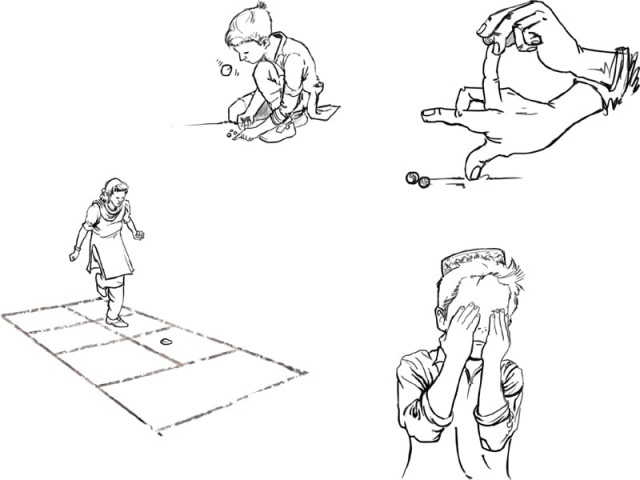
These are the children who play games they have invented or ones that don’t involve a trip to the toy store where their parents will have to fork out hundreds of rupees for Chinese plastic.
Girls, especially those living in predominantly Pashto-speaking neighbourhoods in Karachi, are perhaps the most inventive:
Chindro
Twelve-year-old Tooba likes to play Chindro with her friends in the street outside her home in Masan. She explains that for Chindro you first need a flat circular stone or wooden block and flat surface, which can be the ground. You mark a rectangular box on the ground, divide it vertically in the middle and then horizontally with three lines. This will give you eight boxes.
The players toss a coin and the winner starts the game. Tooba throws the stone in the first box, hops and aims to hit the stone into the box above with her other leg. This continues for all the boxes. If the player touches any line she loses her turn. If you complete a round, on one leg all the while, and get the stone through all eight boxes, you get a point and another turn. It is almost like hopscotch with a few variations; the stone needs to be kicked and not thrown into the box and none of the boxes are numbered. You start by moving up the right column of boxes and coming down the left column.
Bilovri or Kanchay
Bilovries are marbles or glass pieces sold in the market. A number of games are played with bilovries and usually the winner gets to take them home. In one commonly played game, the children try to put the bilvories into a small hole that is about one inch wide and deep from a distance of about five to six feet. To aim, stretch your middle finger back like a bow-string by applying pressure with the forefinger of the right hand. Then shoot the marble by releasing the finger.
Ghotti
“We usually play Ghotti inside rooms in the summer or in the grounds in the evening after we complete our Quran lesson in the seminary,” explained Tehreem, a class 4 student who lives in Keamari. Ghotti is played with five small round stones. Usually two or three girls take part. You put all five stones in the sand and then pick one and throw it in the air. That stone is called the Taak and you can only use one hand in the game. You have to pick up another stone from the sand and catch the Taak before it touches the ground. If you fail to get another stone or catch the Taak, you lose your turn. If any player completes a round with all four stones without letting any of them drop she gets a point and the second turn.
Shalghaatay
Shalghaatay is played between two teams. Team A closes their eyes in a street and Team B marks lines with chalk or charcoal on the wall of a house at some hidden place. Team A has to find those lines.
Published in The Express Tribune, Sunday Magazine, August 25th, 2013.
Like Express Tribune Magazine on Facebook, follow @ETribuneMag on Twitter to stay informed and join the conversation.


















COMMENTS
Comments are moderated and generally will be posted if they are on-topic and not abusive.
For more information, please see our Comments FAQ